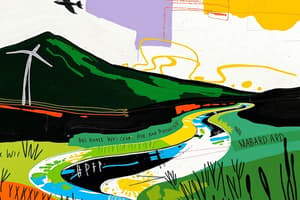Podcast
Questions and Answers
Which of the following best describes the primary role of administrative agencies in the context of laws passed by the U.S. Congress?
Which of the following best describes the primary role of administrative agencies in the context of laws passed by the U.S. Congress?
- To interpret the constitutionality of laws in response to legal challenges.
- To propose new laws and amendments to existing legislation.
- To create specific rules and regulations that implement statutory law. (correct)
- To sign or veto laws passed by Congress based on the President's discretion.
What is the key distinction between a 'law' and a 'regulation' in the U.S. legal system?
What is the key distinction between a 'law' and a 'regulation' in the U.S. legal system?
- Laws apply to citizens, while regulations apply only to businesses.
- Laws are permanent, while regulations are temporary.
- Laws undergo a formal legislative process, while regulations are agency-specific rules. (correct)
- Laws are enforced by agencies, while regulations are enforced through the court system.
Which of the following presents a significant challenge in creating effective environmental policy?
Which of the following presents a significant challenge in creating effective environmental policy?
- Ease of enforcement due to widespread public support.
- A scarcity of available information on environmental issues.
- The alignment of political goals with ecological realities. (correct)
- The presence of a single, unified stakeholder perspective.
In the process of creating environmental policy, which step involves actively seeking support from various groups and individuals?
In the process of creating environmental policy, which step involves actively seeking support from various groups and individuals?
How did the understanding of resources in the American West influence the shift in U.S. environmental policy?
How did the understanding of resources in the American West influence the shift in U.S. environmental policy?
What is the primary purpose of the National Environmental Policy Act (NEPA)?
What is the primary purpose of the National Environmental Policy Act (NEPA)?
Which of the following best describes 'sustainable development'?
Which of the following best describes 'sustainable development'?
Which of the following scenarios exemplifies how international treaties can pose challenges to environmental protection?
Which of the following scenarios exemplifies how international treaties can pose challenges to environmental protection?
What fundamental principle does the environmental justice movement seek to address?
What fundamental principle does the environmental justice movement seek to address?
What event is widely recognized as a key catalyst for the environmental justice movement in the United States?
What event is widely recognized as a key catalyst for the environmental justice movement in the United States?
Flashcards
What is a policy?
What is a policy?
A formal set of rules or guidelines designed to address a specific problem or issue.
What is public policy?
What is public policy?
Policies created by governments, including laws, regulations, orders, and initiatives, aimed at advancing social welfare.
What is environmental policy?
What is environmental policy?
Policies that specifically relate to human interactions with the environment, aiming to manage or improve those interactions.
Who are non-governmental actors in policy making?
Who are non-governmental actors in policy making?
Signup and view all the flashcards
What is Incentive-based (market) environmental policy?
What is Incentive-based (market) environmental policy?
Signup and view all the flashcards
What is Regulatory environmental policy?
What is Regulatory environmental policy?
Signup and view all the flashcards
What is the difference between a law and a regulation?
What is the difference between a law and a regulation?
Signup and view all the flashcards
What are the steps to create environmental policy?
What are the steps to create environmental policy?
Signup and view all the flashcards
What is Sustainable Development?
What is Sustainable Development?
Signup and view all the flashcards
What event sparked the environmental justice movement?
What event sparked the environmental justice movement?
Signup and view all the flashcards
Study Notes
- Policies are formal sets of rules or guidelines designed to address a specific problem.
- Public policy is established by governments through laws, regulations, orders, and initiatives.
- These policies aim to improve social welfare.
- Environmental policy specifically addresses the interactions between humans and the environment.
Benefits of Policy
- Policies can intervene in situations where markets are unwilling to act.
- Policies establish binding agreements for both current and future users of resources.
- They encourage individuals to consider long-term consequences and act in a way that benefits the future.
Actors in Policy Making
- Governmental bodies are stakeholder-based.
- Passing laws can be challenging, governmental bodies have greater accessibility to the courts.
- Non-governmental entities include individuals, non-state actors, businesses, scientists, and the media.
- Non-governmental policy influence is based on community approaches.
- Non-governmental organizations influence policy stakeholders through research and lobbying.
- Non- governmental organizations provide the groundwork for governmental agencies to act.
Challenges of Science in Policy Making
- Science provides the foundation for effective policy making by clarifying the roots of problems.
- Policy makers might distort science by manipulating data.
- Policy makers might distort science by censoring information.
- Policy makers might distort science by appointing unqualified individuals to positions of power.
- Policy makers might distort science by misleading the public.
Incentive vs. Regulatory Based Policy
- Market-based (incentive) policies offer advantages by creating incentives for the private sector to reduce pollutants.
- Market-based policies can be challenging due to the difficulty in valuing resources.
- Market-based policies can be challenging because of the permission of some pollution.
- Examples of market-based policies include tradable pollution credits and tax codes.
- Regulatory policies work well in land use management and are straightforward.
- Regulatory policies can be more costly and less flexible.
- Examples of regulatory policies include the Endangered Species Act and Clean Air and Water Acts.
Creating and Passing Laws in the U.S. Federal Government
- The U.S. federal government has three branches: legislative, judicial, and executive.
- The legislative branch is involved in passing laws through the House of Representatives or Senate.
- The judicial branch rules on the legality of laws or conflicts and assesses the constitutionality of laws.
- The executive branch, led by the President, signs or vetoes laws passed by Congress.
- A fourth branch implements all of laws: administrative agencies, which issue specific regulations based on statutory law.
Laws vs. Regulations
- Laws undergo a bill process before being established and have rules that govern equally.
- Regulations affect those who directly interact with the agency enforcing them.
Challenges of Creating Environmental Policy
- Differing political and ecological frames
- Difficulty in creation and enforcement
- Information overload and deficit
- Wide variety of stakeholders
Steps in Creating Environmental Policy
- Identify the problem through curiosity, observation, and awareness.
- Identify the underlying causes of the problem through scientific research.
- Develop potential solutions and establish goals through scientific, social, and political action.
- Get organized.
- Cultivate access and influence (lobbying and environmental advocacy).
- Manage the development of the policy by preparing a bill or drafting a law that contains solutions.
Phases of U.S. Environmental Policy
- Management of lands promoted settlement and extraction of natural resources in the West.
- Addressing environmental problems was caused by westward expansion, including resources in the West are exhaustible and require legal protection.
- Responding to Pollution
- Increased public awareness of environmental problems shifted public priorities and policy.
Environmental Policy Phases
- Management of lands characterized by the Land Ordinance of 1785, which split up land west of Appalachians to move people from the east, and the Homestead Act of 1862.
- Homestead Act of 1862 provided a way to obtain cheap land with inexhaustible resources.
- Addressing environmental problems caused by westward expansion lead to the creation of national parks like Yellowstone because people realized that resources were inexhaustible
- Responding to pollution included the NEPA, the EPA, and Sustainable Development
NEPA and Environmental Policy
- National Environmental Policy Act (NEPA) requires an environmental impact assessment for any federal action impacting the government.
- NEPA forces businesses and the government to evaluate the possible environmental impacts of a project.
EPA & Sustainable Development
- The Environmental Protection Agency (EPA) uses an integrated approach to environmental policy.
- The EPA conducts and evaluates research.
- The EPA monitors environmental quality.
- The EPA sets pollution levels.
- Sustainable development looks at a pattern of urban, social, and economic growth with the purpose of improving actual and future generations.
- Sustainable development improves life through the restoration and preservation of ecological services.
Definitions
- Convention: international meeting of representatives that results in general agreement about procedures or actions on specific topics
- Protocol: preliminary agreement often formulated as the basis for a final convention or treaty.
- Ratification: formal approval agreement/convention.
Challenges of International Treaties
- International treaties can weaken environmental protection laws.
- Treaties can discourage states and nations from passing new environmental protection laws due to monetary incentive.
- Treaties may allow industries/corporations to weaken protection laws, that are seen as a trade barrier.
Environmental Justice
- Environmental justice reflects the reality that vulnerable communities are often subject to the worst pollution.
- Environmental justice involves fair treatment of everyone, regardless of race, income, or ethnicity.
- Low-income and minority communities are disproportionately exposed to pollution, hazards, and environmental degradation.
- Environmental justice movement was sparked by a sit-in against the NC PCB landfill.
Examples of Environmental Racism
- Sugar industry in Pahokee, Florida
- Paper mills in Africatown, Alabama
- PCBs dumped by Burlington Industries in Cheraw, South Carolina
- Toxic coal ash in Uniontown, Alabama
Progression of Environmental Justice Movement
- Environmental justice movement started by people of color to address protection inequality.
- EPA's strategic plan for 2016-2020 builds on Plan EJ 2014.
- Deepening environmental justice practice within EPA programs aims to improve health/environment.
- Working with partners expands environmental justice impact.
- Demonstrating progress on national environmental justice challenges
Environmental Justice & Climate Change
- Communities/groups of people that are more vulnerable need more time to adapt to climate change.
- Climate adaptation is more difficult due to experiencing multiple environmental health burdens.
Studying That Suits You
Use AI to generate personalized quizzes and flashcards to suit your learning preferences.
Related Documents
Description
Explore the role of policies as formal rules designed to tackle specific problems, especially in public and environmental contexts. Learn about governmental and non-governmental actors in policy making. Discover how policies drive social welfare and ensure sustainable resource use.




